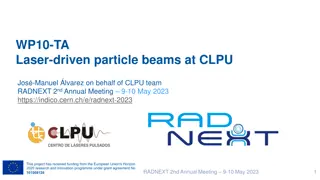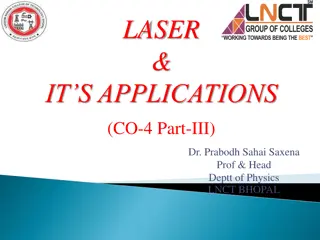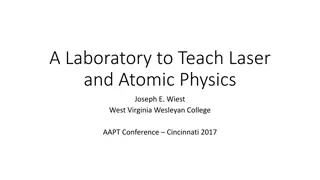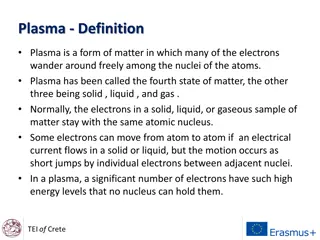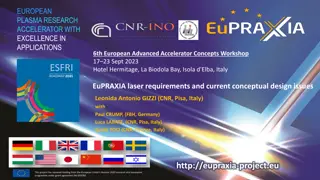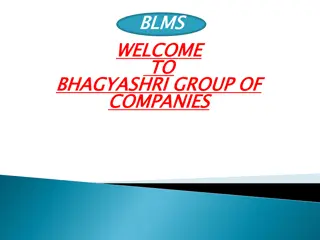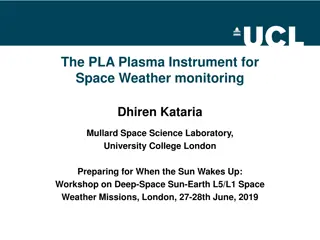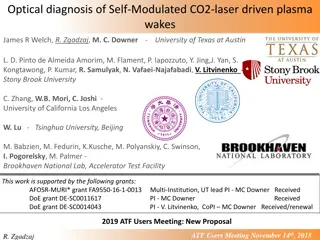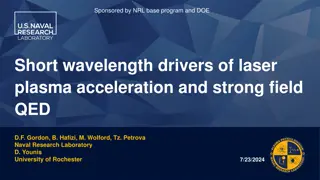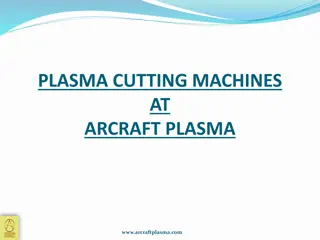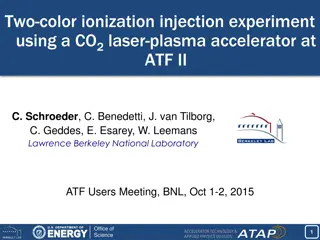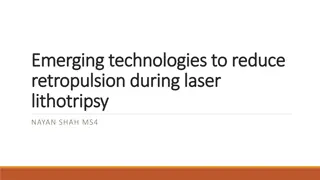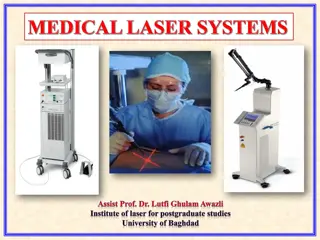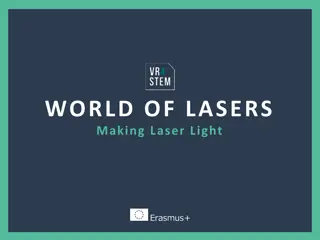EuPRAXIA Working Package Report: High Gradient Laser Plasma Accelerating Structure
EuPRAXIA working package report on WP3 and WP4 focuses on High Gradient Laser Plasma Accelerating Structure and Laser Design and Optimization. WP3, led by B. Cros and Z. Nujmudin, involves defining operation regimes, designing plasma structures, chamber environments, diagnostics, and staging plasma structures. The tasks include designing the plasma injector, matching electron beam and plasma parameters, and addressing issues like synchronization and spatial overlap. WP4, led by L. Gizzi and F. Mathieu, focuses on laser design and optimization. The activities with the FLAME laser are closely related to both WP3 and WP4.
Download Presentation

Please find below an Image/Link to download the presentation.
The content on the website is provided AS IS for your information and personal use only. It may not be sold, licensed, or shared on other websites without obtaining consent from the author.If you encounter any issues during the download, it is possible that the publisher has removed the file from their server.
You are allowed to download the files provided on this website for personal or commercial use, subject to the condition that they are used lawfully. All files are the property of their respective owners.
The content on the website is provided AS IS for your information and personal use only. It may not be sold, licensed, or shared on other websites without obtaining consent from the author.
E N D
Presentation Transcript
EuPRAXIA working package report WP3 and WP4
WP3 and WP4 WP3 is on High Gradient Laser Plasma Accelerating Structure WP Leaders B. Cros (CNRS) and Z. Nujmudin (Imperial College) WP4 is on Laser Design and Optimization WP Leaders L.Gizzi (CNR Pisa) and F. Mathieu (CNRS) Are strictly connected. Our current activities with the FLAME laser are strongly related to both the WPs.
WP3 - High Gradient Laser Plasma Accelerating Structure
WP3 - High Gradient Laser Plasma Accelerating Structure Task 3.1: Define regime of operation Task 3.2: Design plasma structure Plasma creation, laser confinement, injection techniques Task 3.3: Design plasma chamber and environment Vacuum, activation Task 3.4: Diagnostics Laser focusing, alignment, control, laser beam dumping Task 3.5: Staging plasma structures Laser-plasma coupling (plasma mirrors), synchronization, overlap at the plasma entrance
WP3 - High Gradient Laser Plasma Accelerating Structure Is it all plasma based accelerator? If yes: how to design the plasma injector? e- beam quality required? If no: what are in input e- beam parameters? Electron beam properties and plasma parameters needs to be matched. The regime of work need to be defined (linear, quasi linear ) Diagnostic strongly depends on the plasma parameters. Rep rate important for vacuum issues.
WP3 - High Gradient Laser Plasma Accelerating Structure Why this two tasks? Mainly are the issue we will have already faced for THOMSON and that we will have to solve for EXIN (synchronization, spatial overlap and so on). Diagnostic as well is an expertise that we are growing both for LWFA at FLAME and for COMB. Mainly it s plasma diagnostic at different plasma density.
WP4 Laser Design and Optimization
WP4 - Laser Design and Optimization Task 4.1: Management and system engineering Task 4.2: Laser design study Task 4.2.1: Benchmarking Task 4.2.2: Front-end Task 4.2.3: Power amplification section Task 4.2.4: Stretching, compression and Transport Task 4.2.2: Diagnostics Task 4.3: Transverse functions, alignment and control, active stabilization, synchronization Task 4.4: Laser control system
WP4 - Laser Design and Optimization How many lasers to guarantee 24/7 operation? Is high rep rate the way to have more stability? How many photon beams are needed (mains and probes)? Do we have to use the some laser for the photocathode? Are requirements comparable? 1003 solution: 100 J, 100 fs, 100 Hz. Is it technologically feasible. Stabilization of the beam might be thought to be done from oscillator. Is Ti:Sa a feasible solution or other material for the pumping part need to be taken into account?
WP4 - Laser Design and Optimization Task 4.1: Management and system engineering Task 4.2: Laser design study Task 4.2.1: Benchmarking Task 4.2.2: Front-end Task 4.2.3: Power amplification section Task 4.2.4: Stretching, compression and Transport Task 4.2.2: Diagnostics Task 4.3: Transverse functions, alignment and control, active stabilization, synchronization Task 4.4: Laser control system
WP4 - Laser Design and Optimization Why this tasks? FLAME update will be necessary for EuSPARC and we can definitely gain from the study of the laser. Also, during these years, we have been working intensively on the laser side in order to have the best performances and high stability and reproducibility. The task on synchronization is strongly related to that of WP3.
WP3 and WP4 tasks what we are doing already We are already working on all the tasks where we have proposed ourselves: Laser optimization and stabilization Plasma accelerators studies Diagnostics
In the mean time at FLAME Laser optimization and stabilization Focal spot diffraction limited, with 60% energy in the 1/e2 diameter. Mainly compressor optimization and controlled transport. Higher stability achieved with temperature control (from clean room down to the bunker) and by tubing all the laser transport section in order to avoid turbulence.
In the mean time at FLAME Plasma accelerators studies Using only 2J of energy and 2 mm gas-jet, 350 MeV electron bunches with mrad divergence, high charge, small energy spread have been produced. The corresponding integrated accelerating field is of about 200 GV/m. 350 MeV 100 MeV 50 MeV
In the mean time at FLAME Source optimization and parametric study of the laser and plasma parameters is undergoing. So scanning density, electron energy has been varied from 50 MeV, to 175 MeV and up to 300 MeV. for example the by plasma 174 MeV 57 MeV 236 MeV 81 MeV Also by tuning plasma density, energy spread has been reduced from 100% to 20%.
In the mean time at FLAME Diagnostics MacZender interferometer to measure the plasma density. OTR to measure the electron beam emittance. Betatron radiation to measure beam quality inside the plasma bubble.


